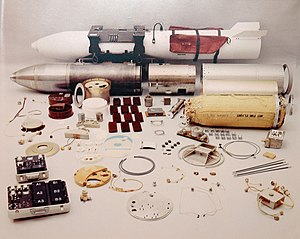B83 nuclear bomb
| B83 | |
|---|---|
 |
|
| Type | Unguided bomb |
| Service history | |
| In service | 1983–present |
| Used by | United States |
| Production history | |
| Designer | Lawrence Livermore National Laboratory |
| Number built | 650 |
| Specifications | |
| Weight | 1,100 kilograms (2,400 lb) |
| Length | 3.7 meters (12 ft) |
| Diameter | 46 centimeters (18 in) |
|
|
|
| Blast yield | 1.2 megatonnes of TNT (5.0 PJ) (maximum) |
The B83 thermonuclear weapon is a variable-yield gravity bomb developed by the United States in the late 1970s, entering service in 1983. With a maximum yield of 1.2 megatonnes of TNT (5.0 PJ) (75 times the yield of the atomic bomb "Little Boy" dropped on Hiroshima on 6 August 1945, which had a yield of 16 kilotonnes of TNT (67 TJ)), it is the most powerful nuclear free-fall weapon in the United States arsenal. It was designed at Lawrence Livermore National Laboratory, and the first underground test detonation of the production B83 took place on 15 December 1984.
The B83 was based partly on the earlier B77 program, which was terminated because of cost overruns. The B77 was designed with an active altitude control and lifting parachute system for supersonic low-altitude delivery from the B-1A bomber. B77 nuclear component test firings were attributed to the Operation Anvil (Nuclear test) series in 1975 and 1976, specifically the "Cheese" test shots in Anvil:
The B83 nuclear components have been attributed as the same as the earlier B77.
The B83 replaced several earlier weapons, including the B28, B43, and to some extent the ultra-high-yield B53. It was the first U.S. nuclear weapon designed from the start to avoid accidental detonation, with the use of "insensitive explosives" in the trigger lens system. Its layout is similar to that of the smaller B61, with the warhead mounted in the forward part of the weapon to make the bomb nose-heavy. It was intended for high-speed carriage (up to Mach 2.0) and delivery at high or low altitude. For the latter role, it is equipped with a parachute retardation system, with a 14-meter (46 ft) Kevlar ribbon parachute capable of rapid deceleration. It can be employed in free-fall, retarded, contact, and laydown modes, for air-burst or ground-burst detonation. Security features include next-generation permissive action link (PAL) and a command disablement system (CDS), rendering the weapon tactically useless without a nuclear yield.
...
Wikipedia
